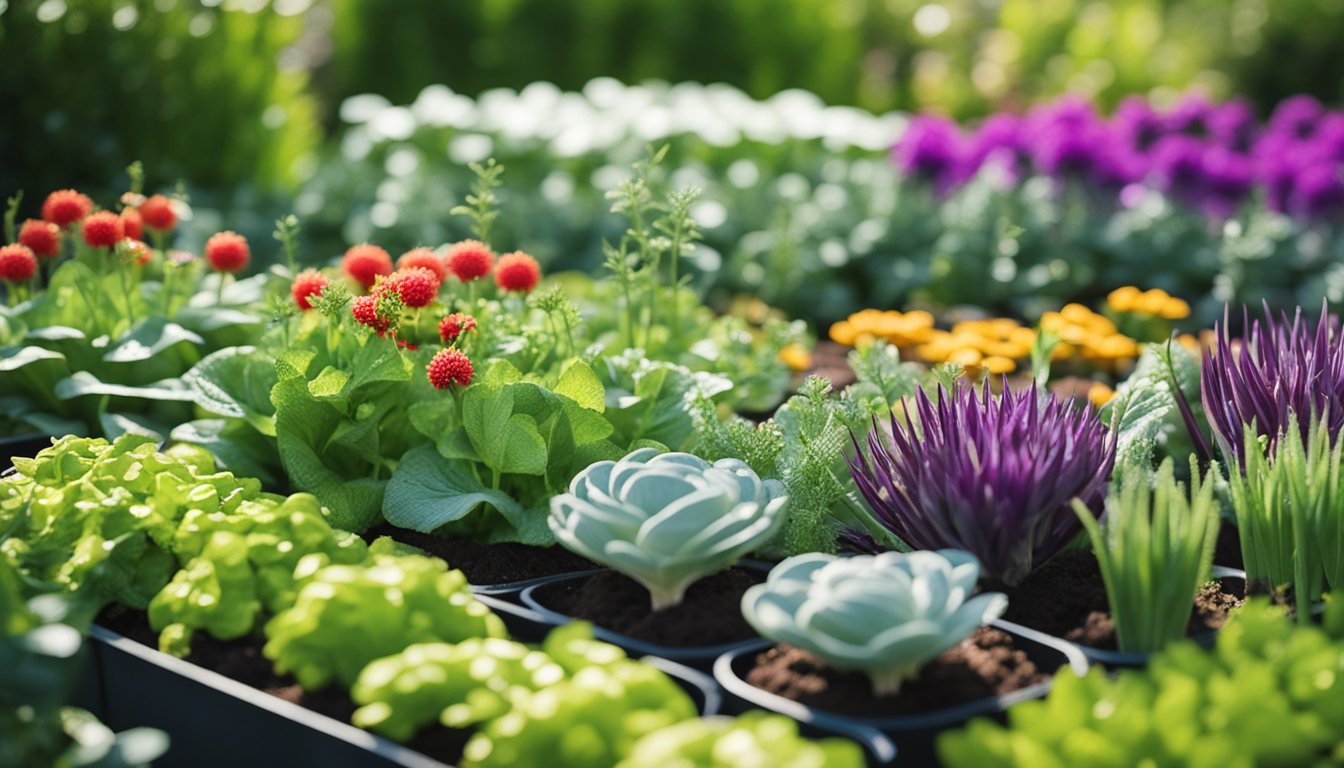Imagine stepping into your garden and plucking fresh veggies without the hassle of replanting each year. That’s the magic of perennial vegetables. These hardy plants not only save you time and effort but also provide a continuous harvest season after season. They’re the unsung heroes of sustainable gardening, offering a delicious way to diversify your meals while reducing your environmental footprint.
I’ve discovered that incorporating perennial vegetables into my garden has transformed how I think about food production. From nutrient-rich asparagus to vibrant rhubarb, these plants bring both flavor and resilience to my table. If you’re ready to embrace a gardening method that thrives with minimal maintenance, let’s dive into the world of perennial vegetables and unlock the potential of your garden.
Overview of Perennial Vegetables
Perennial vegetables thrive in gardens, offering a reliable source of food year after year. Unlike annual crops, these plants keep growing from the same root system, which means less effort for me as a gardener. I enjoy the convenience of harvesting asparagus and rhubarb every spring without replanting.
These hardy vegetables often require little maintenance. Most of them resist pests and diseases better than traditional annual crops. I appreciate knowing that my garden can stay productive with minimal intervention.
Perennial vegetables also contribute to soil health. Their deep root systems enrich the soil and prevent erosion. I find this balance between ecology and productivity essential in my gardening journey.
Several perennial vegetables stand out. Asparagus, with its tender spears, brings a burst of flavor to my dishes. Rhubarb, known for its tartness, makes excellent pies. Other remarkable options include Jerusalem artichokes and sorrel, each adding unique tastes to my meals.
Investing in perennial vegetables pays off in the long run. They offer consistent harvests, enrich my garden, and reduce the effort needed each season. I enjoy the sustainability they bring to my gardening practices. Plus, it’s always fun to surprise guests with something unique from my garden that they haven’t tried before.
Benefits of Growing Perennial Vegetables

Growing perennial vegetables offers numerous advantages. They provide a continuous harvest each year, reducing the need for annual replanting. This makes gardening easier and more efficient.
Environmental Advantages
Perennial vegetables support soil health. Their deep root systems improve soil structure and reduce erosion. These plants also require less water compared to annuals. They create a natural habitat for beneficial insects and wildlife. I enjoy watching pollinators thrive in my garden, enhancing biodiversity. Fewer inputs mean less reliance on fertilizers and pesticides. This promotes a healthier ecosystem for everyone involved.
Nutritional Value
Perennial vegetables deliver impressive nutrition. They often contain more vitamins and minerals than their annual counterparts. Asparagus, for example, boasts high levels of vitamin K and folate. Rhubarb packs a punch with antioxidants. Eating these veggies helps support a balanced diet. Plus, they grow in a variety of flavors, adding zest to any dish. I appreciate having unique options at my fingertips; it keeps meals exciting and nutritious.
Popular Types of Perennial Vegetables
Perennial vegetables bring flavorful diversity to the garden. I enjoy growing these hardy plants for the benefits they offer. Below are some popular choices.
Asparagus

Asparagus ranks high on my list of favorite vegetables. This nutrient-packed plant provides a delicious, tender shoot that pops up in early spring. It delights the taste buds and shines in dishes like stir-fries or pasta. To grow asparagus, I plant crowns in well-drained soil and let them establish for a couple of years. Patience pays off; once established, they produce for 15 to 20 years. Talk about a long-term commitment!
Rhubarb
Rhubarb adds a unique tartness to my garden. This vibrant plant, with its large green leaves and striking red stalks, produces a refreshing flavor in pies and jams. Rhubarb thrives in rich, moist soil. When I’m ready to harvest, I cut the stalks at the base, leaving some behind for continuous growth. It’s a fun challenge because it’s technically a vegetable but often treated as a fruit. Surprise your friends at dinner with this tasty twist!
Cultivation Techniques for Perennial Vegetables
Growing perennial vegetables simplifies gardening and ensures a steady harvest. Using effective cultivation techniques maximizes their benefits.
Soil Preparation
Preparing the soil sets the foundation for successful perennial vegetable growth. Start with a thorough soil test. Knowing pH and nutrient levels helps tailor amendments for better plant health. I often add organic matter such as compost, which improves soil structure and boosts fertility. Tilling the soil to a depth of 12 to 18 inches allows roots to penetrate deeply. Mixing in amendments should be done at least a couple of weeks before planting to promote microbial activity.
Maintenance and Care
Caring for perennial vegetables involves a mix of regular tasks. Water them well during the first season after planting. Deep watering encourages strong root development. Mulching around plants retains moisture and reduces weeds. I prefer using straw or shredded leaves for a natural look. Pruning helps stimulate growth and improve air circulation. Don’t forget to monitor for pests and diseases! Early detection prevents bigger issues down the road.
Feeding perennial vegetables with organic fertilizers each spring keeps them thriving. Asparagus and rhubarb appreciate extra nutrition, particularly when they begin to grow vigorously. With minimal effort, these plants have rewarded me with delicious food for years. Gardening can be a walk in the park when I apply these techniques.
Before You Go – Growing Perennial Vegetables

Embracing perennial vegetables has truly transformed my gardening experience. These resilient plants not only save time and effort but also enrich my meals with unique flavors and nutrients. The benefits extend beyond convenience; they support soil health and foster biodiversity in my garden.
As I continue to cultivate options like asparagus and rhubarb, I’m reminded of the balance between productivity and ecological responsibility. With minimal maintenance and a focus on sustainable practices, I’m excited to see how my garden evolves year after year. If you’re looking to enhance your gardening journey, I encourage you to explore the world of perennial vegetables. You won’t be disappointed. Don’t forget to add The Herb Prof to your favorites so you don’t miss out on future articles.
References – Growing Perennial Vegetables
Little Herb Encyclopedia, by Jack Ritchason; N.D., Woodland Publishing Incorporated, 1995
The Ultimate Healing System, Course Manual, Copyright 1985, Don Lepore
Planetary Herbology, Michael Tierra, C.A., N.D., Lotus Press, 1988
Handbook of Medicinal Herbs, by James A. Duke, Pub. CRP Second Edition 2007
The Complete Medicinal Herbal, by Penelope Ody, Published by Dorling Kindersley
Check the Following Articles
Turkey Tail Benefits: Immune Health & Gut Wellness Boost
Discover the Best Tea for High Blood Pressure
The Amazing Maitake Mushroom Benefits for Your Health
Master Cold Tolerance in Avocados: A Guide to Growing
Frequently Asked Questions – Growing Perennial Vegetables
What are perennial vegetables?
Perennial vegetables are plants that grow back year after year without needing to be replanted. They provide continuous harvests and are generally hardier than annual crops, making them ideal for sustainable gardening.
Why grow perennial vegetables?
Growing perennial vegetables offers numerous benefits, including reduced maintenance, improved soil health, and increased biodiversity. They thrive with less water and create habitats for beneficial insects while providing reliable food sources.
What are some examples of perennial vegetables?
Popular perennial vegetables include asparagus, rhubarb, Jerusalem artichokes, and sorrel. These plants are known for their unique flavors and can enhance the diversity of your garden while offering nutritional benefits.
How do I maintain perennial vegetables?
Maintenance includes soil preparation with organic matter, deep watering, mulching, and occasional pruning. Regular feeding with organic fertilizers in spring is crucial for ensuring healthy growth and productivity.
Do perennial vegetables need pests and disease management?
Perennial vegetables generally resist pests and diseases better than annual crops. Their deep root systems contribute to soil health, reducing the need for chemical interventions and promoting a healthier garden ecosystem.
How do perennial vegetables benefit soil health?
Perennial vegetables improve soil structure and reduce erosion, thanks to their deep-root systems. They also contribute organic matter to the soil, enhancing its fertility and overall health over time.
Can perennial vegetables save me time in gardening?
Yes, perennial vegetables require less effort to be replanted each year, allowing gardeners to enjoy continuous harvests with minimal upkeep. This efficiency can free up time for other gardening activities or hobbies.
What nutritional benefits do perennial vegetables offer?
Many perennial vegetables, such as asparagus and rhubarb, are rich in vitamins and minerals. For example, asparagus is high in vitamin K and folate, while rhubarb offers antioxidants, providing essential nutrients for a healthy diet.

